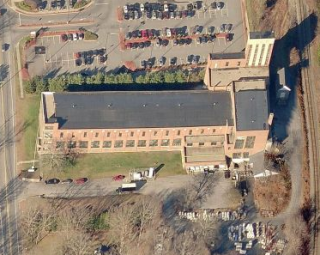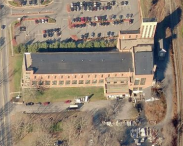Mill Record Killingly
RETURN TO ‘FIND MILLS’Disclaimer: Content for these properties was compiled in 2014-2017 from a variety of sources and is subject to change. Updates are occasionally made under Property Information, however the Connecticut Trust for Historic Preservation (dba Preservation Connecticut) makes no representation or warranty that the information is complete or up-to-date.
- Complex Name (Common)
- V. LaRosa and Sons Inc.
- Complex Name (Historic)
-
- V. LaRosa and Sons Inc.
- Address or Location
- 90 Wauregan Road, Danielson, Killingly
- County
- Windham
- Historic Designation
- Associated Mill Community
- n/a

- Historic Information
Companies Associated w/Complex
- V. LaRosa and Sons Inc. 1940-ca. 1975
Use (Historic)
Largest Documented Workforce
70 (1941)
Historic Narrative
The V. La Rosa and Sons Macaroni Company was established in Brooklyn, New York by Sicilian immigrant Vincenzo La Rosa in 1914. The company grew to national prominence during the 1930s, this largely driven by its ground-breaking introduction of pre-packaged macaroni products. By 1938, the firm employed over 300 workers at its Brooklyn factory, and additional plants were soon erected in Warminster, Pennsylvania; Milwaukee, Wisconsin; and Killingly, Connecticut. The latter was built to supply the company’s New England markets, and was completed in 1940. At the time of its opening, the V. La Rosa and Sons Macaroni Company’s Killingly plant was credited as being the most modern macaroni factory in the world. It was specifically built for that purpose and had been designed to accommodate the most advanced automated machinery available in the world at the time. A Hartford Courant article published in March 1941 noted that automation nearly eliminated human handling of the product and despite being over 95,000 square feet in size the Danielson plant needed just 70 employees to run at full capacity. The factory manufactured over 130 types of macaroni and could turn out over 150 tons of product per five-day workweek. As noted, these were shipped to La Rosa’s New England markets, which included Hartford and New Haven, Connecticut; Boston, Massachusetts; and Providence, Rhode Island. The La Rosa brand remained prominent throughout the middle of the twentieth century. This was largely driven by both constant marketing campaigns, as well as the firm’s entry into the frozen food business during the late-1950s. The company’s Danielson plant was decommissioned by the 1970s, at which time it was adapted for textile production. The company was eventually acquired by the Archer Daniels Midland Company in 1986. The V. La Rosa and Sons Macaroni Company plant was most recently occupied by both Siri Wire, a manufacturer of stainless steel wire; and Vegware, a producer of biodegradable and compostable tableware.
- Architectural Information
Number of Existing Buildings
Six (6) primary blocks.
Dates of Construction
1940, ca. 1960.
Architect
Leo F. Caproni
Builder
n/a
Building Type
Architectural Description
The former V. La Rosa and Sons Macaroni Company plant is comprised of approximately six adjoining primary blocks located on the east side of Wauregan Road (CT Route 12), roughly 450’ north of its intersection with Cady Street. The mill’s main manufacturing building consists of a three-story, 84’ x 318’ steel-frame and concrete block structure erected in 1940. It has a concrete foundation, red brick exterior walls, concrete window sills, and a brick parapet with concrete coping that hides the structure’s low-pitch gable roof. The building’s façade is notable for its International Style details, which include tall ribbon windows that wrap around the northwest and southwest corners of the block. The southwest corner of the building rises in a four-story tower, the fourth floor of which repeats the use of wrap-around ribbon windows. The block’s north and south (side) elevations are broken into full-height bays by brick piers. These have tall, full-width windows with metal sash spanning the first and second floors, and more narrow metal sash on the third. A brick entry porch sheltering the primary entrance to the building is located at the southwest corner of the building. This has a flat roof and concrete trim details. The plant’s five ancillary blocks adjoin the north elevation and the eastern end of the main block. These stand between one and four stories in height and are of steel-frame, concrete block, and brick veneer construction with flat roofs. Those dating to the factory’s original construction include a one-story, 24’ x 100’ block at the center of the north elevation; a 56’ x 88’ block at the eastern end of the south elevation; and a three-story, 60’ x 125’ block along the main block’s east elevation. Further additions, including a three-story, 60’ x 100’ block with a four-story tower located at the eastern end of the main block’s north elevation; and a one-story, 47’ x 32’ loading dock at the southeast corner of the plant, were likely erected ca. 1950. Boiler plant added in 1943 per 5/17 Steel Magazine.
Exterior Material(s)
Structural System(s)
Roof Form
Roof Material
Power Source
Condition
Good
Condition Notes
The factory is in overall good condition.
- Property Information
-
Specific Location
One 5.0-acre parcel (90 Wauregan Road) on the east side of Wauregan Road (CT Route 12), roughly 450’ north of its intersection with Cady Street.
Adjacent To
n/a
Exterior Visible from Public Road?
Yes
Parcel ID / Assessor Record Link
- 217/58 / Link →
Acreage
5.0
Use (Present)
- Sources
-
Form Completed By
Lucas A. Karmazinas
Date
04/13/2015
Bibliography
- List of Connecticut Manufacturers, 1922, 1924, 1930, 1932.
- Directory of Connecticut State Manufacturers, 1936, 1939.
- Industrial Directory of Connecticut, 1947.
- Register of War Production Facilities in Connecticut, 1951.
- Map of Windham County, E.M. Woodford, 1855.
- Atlas of Windham County, O.W. Gray, 1869.
- Sanborn Map Company, 1884, 1892, 1897, 1903, 1911, 1927, 1939.
- Hartford Courant, 1940, 1941, 1958.
- A History of Windham County, Connecticut; Bayles, Richard M., ed., 1889.
- A Modern History of Windham County, Connecticut; Lincoln, Allen B., 1920.
- Information, historic photographs and sources for Leo Caproni courtesy Gregg Bateman (2018).
- Caproni, Leo F., ‘Industrial Buildings’ (1942 booklet)
- Representative View(s)Click on image to view full file





_195_114.jpg)



